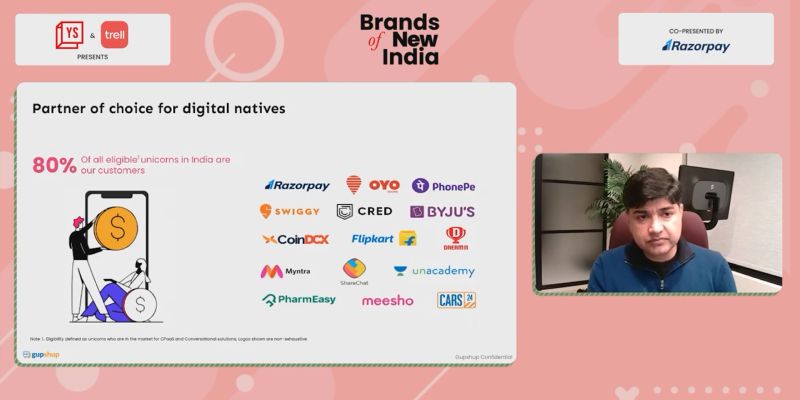“Imagine the whole gamut of experience on the internet that got re-imagined as mobile applications in the conversational medium. Customers now want their business conversations to become interactive, responsive, and personalised,” said Gaurav Kachhawa, Chief Product Officer, Gupshup.

Gaurav was delivering a masterclass on ‘Scaling D2C brands with the power of Conversational Commerce’ at the premier edition of YourStory’s Brands of New India Mega Summit. A new dawn of conversational engagement is being witnessed, and thus, a need is felt for scaling up D2C brands with the power of conversational commerce.
What is conversational engagement?
Today, at least six billion people are engaging in their mobile phones through SMS or i-message, while two billion people can get engaged over WhatsApp. The ubiquity of messaging apps thus opens up a floodgate for a lot of these experiences meant for mobiles or web, to be re-imagined in the conversational medium.
However, we still have a notion that states web experiences don’t work great on the mobile device or mobile applications have additional download friction. Thus, all these proliferations led to cost escalation for phone applications.
“We believe that messaging is well suited for these customer journeys, and are best positioned to deliver all the requirements. 175 million global subscribers have resorted to WhatsApp for business, and in all hopes, the number would only increase,” said Gaurav.
Messaging apps are like the platform where customers want their brands and businesses to be. WhatsApp is followed by Instagram where reports state that almost 90 percent of the users follow at least one brand through the platform.
Lastly, 85 percent of the consumers agree that interacting with businesses over messaging apps helps in building relationships, reaping good benefits of one-on-one conversation.
Where real-time conversations happen
Businesses need to communicate with their customers real-time, 24x7 regardless of the transactions involving confirmations, approval, reminders, etc. Customers get used to receiving notifications from a variety of website applications. “As customer expectations increase, they want to have a two-way conversation, where each of these touchpoints would now change into a conversational and engagement journey – be it informing users about a product or service, specifying details, transactions or check-outs occurring in the messaging channel itself, or the post-purchase customer support,” added Gaurav.
So, virtually every customer touchpoint would be transformed with conversational experiences on the messaging app platforms. For instance, an email can be replaced by a personalised message where 80 percent of the conversation gets handled by a chatbot, but the remaining 20 percent would be supported by the sales agent, in helping people reach the next step in their purchasing journey.
“The automated chatbots and voice bots, supported by the human servicing team, are the new digital storefront, would become more prevalent, exactly the way websites and mobile apps were prevalent through the last few decades,” he said.
The transformative power of conversational commerce
One of the primary challenges of D2C brands, according to Gaurav, is building the brand name, including taking the infrastructure from offline to online, strengthening the relationship with customers, investing in all the acquisition channels, helping customers with the host of products you have, engaging with them, and supporting them post-purchase.
The digital journeys of consumers today mainly depend on brands strengthening their presence online or offline, be it on websites or an application. The customer acquisition cost of driving them to these places is quite high. As a result, companies have to double down on collecting the user information directly, including a lot of the interactive messaging.
“All these lead to lower conversion rates. If the customer gets through the funnel to the shopping cart, and if they have a question they would abandon their shopping cart there, and either they won’t ever come back or do an offline search, or drop an email to support. Now, imagine if this entire thing could be shifted to an automated mode with real-time conversation, right at the point where they are having questions regarding the bot, this entire marketing process could be improved from a growth marketing standpoint,” he said.
Conversational commerce is the transformative solution for establishing an engaging and ever-lasting relationship with your customers, almost like offering a shopping assistant to your customers, but virtually.
Powering growth
Conversational commerce is like the powerhouse that can channel the growth and prosperity of the D2C brands. “The discovery engine would be reaching users as and where they are, and getting hooked on to personalised search, creating menus and mini catalogues based on their search results, so that they can focus on their interest groups, thereby lowering the acquisition cost. Besides, the users can right away ask questions without getting meandered to any other medium,” said Gaurav.
The whole idea remains in optimising the conversion time, where conversational commerce is all about asking the real-time questions and extending the overall real-time support needed in any language while shopping on e-commerce platforms. Of course, this further leads to strengthening the relationship with your customers, while capturing their feedback, driving loyalties, and announcing rewards as they engage more with the brand.
You can watch videos from all the sessions of Brands of New India Mega Summit here. Don't forget to tag #BrandsOfNewIndia when you share your experience, learnings, and favourite moments from the event on social media.
For information on future events, collaborations, and information regarding the D2C ecosystem, please visit our website.
